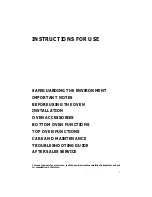
Duke Manufacturing Co.
2305 N. Broadway
•
St. Louis, Missouri
800-735-3853
•
314-231-1130
•
Fax 314-231-5074
www.dukemfg.com
13 of 22
B. GENERAL GUIDELINES FOR
OPERATION
These guidelines are to assist you in obtaining the
best performance from your oven:
•
Always pre-heat your oven before cooking
by placing the temperature setting at the
desired temperature. The oven is pre-heated
when the Indicator Light goes out.
•
Always use a lower temperature setting than
that
recommended
for
a
standard
conventional oven or range oven. The
general rule of thumb is to subtract 50 -
100°F from the standard oven recipe. Some
experimentation on your part may be
necessary to achieve the optimum results
with your food products.
Cooking at higher temperatures will not
reduce your cooking time! It will produce
unsatisfactory
baking
and
roasting
results.
•
You should begin checking the doneness of
your food product in about half the time
recommended for the same recipe cooked in
a standard oven. There is a Suggested Time
and Temperature Chart on the next page,
which can serve as a guide. Keep in mind
that your times may vary depending on the
amount of product being cooked in your
oven. The best results are always achieved
when a systematic record of times and
temperatures is kept for reference.
•
The oven will hold up to thirteen 18" x 26"
(457mm x 660mm) sheet pans. Your
product and pan height will determine how
many racks can be loaded.
Do not place an empty sheet pan or
aluminum foil on the bottom of the oven.
This will disrupt the airflow and cause
uneven cooking results.
•
To minimize the shrinkage of roasted
meats, place the meat directly on the racks
and place a sheet pan one half full of water
in the bottom rack position. The water will
keep the oven compartment more humid
and the meat juices will evaporate less.
•
Maintain equal loads when cooking more than one pan of
product at a time. You may wish to weigh the product to
assure that the pan loads are equal. Smaller loads in one pan
will cook at a different rate than larger ones in another.
•
You may wish to experiment with leaving the oven OFF
after pre-heating the oven and loading when baking light
products such as light cake batter or custard so the product
will have time to set. Normally, 7-10 minutes with the oven
OFF, then finishing with the oven ON, will keep the product
from rippling or being pushed by the fan.
•
When starting off with frozen product, you may wish to pre-
heat your oven up to 100° F above the temperature you are
going to cook. Load the product and reset the temperature for
the normal time.
•
For longer bulb life, do not leave the oven lights on when not
viewing the product.
IMPORTANT NOTE: When an oven is supplied
on casters and is connected to the supply piping by
means of a connector for movable appliances, the
oven must be equipped with a restraint and, if
disconnection of the restraint is necessary,
reconnect this restraint after the oven has been
returned to its originally installed position.








































